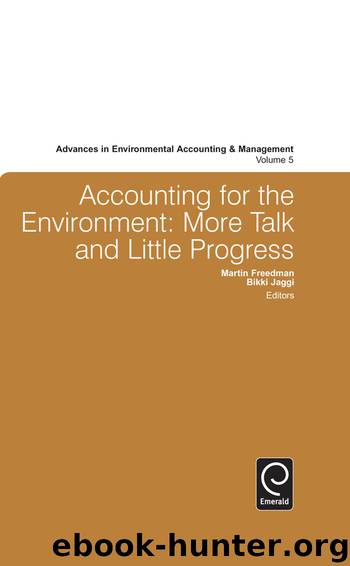Accounting for the Environment by Bikki Jaggi

Author:Bikki Jaggi
Language: eng
Format: epub
Publisher: Emerald Group Publishing Limited
Published: 2014-03-14T16:00:00+00:00
Risk-Based TRI
TRI (EPA, 2010, http://www.epa.gov/tri/) is a raw database which provides information on annual releases of hazardous chemicals (so designated by the EPA) from US plants and was created so that the community would be aware that local plants were emitting these dangerous pollutants (Konar & Cohen, 1997). This section of the Superfund legislation was considered the “community right to know.” TRI is available online from the EPA. One advantage of TRI is that it can be used as a measure of corporate pollution. The emissions can be provided by chemical and by destination (air, water, or land). Although it does not include all the different types of pollutants it does include the ones that are most immediately hazardous.
However, TRI has a number of limitations as a tool for measuring corporate pollution performance. The emissions consist of only hazardous chemicals as defined by the EPA. Other pollutants such as sulfur oxides, nitrogen oxides, carbon dioxide, particulates, and measures such as total suspended solids and bio-oxygen demand are not included in TRI. Much of the research using TRI uses total emissions and considers all chemical releases to be equal (see, e.g., Freedman & Patten, 2004; Hamilton, 1995). TRI is only available on a plant basis so using it to determine corporate pollution can be a difficult task.
Recently in the environmental and ecological literature more comprehensive metrics are developed to measure the impact of pollutants. Toxicologists have assessed the toxicity of an individual hazardous chemical and derived a weighting of toxicology by each chemical (EPA, 1990b; SRC, 2002). Models to quantify the diffusion of toxic chemicals and the exposure of humans to these chemicals have also been built (EPA, 1986a, 1986b, 1988, 1990a, 1991a, 1991b, 2007). Furthermore, the population density around the release can be accurately estimated with the aid of Geographic Information Systems and US Census data. These scientific advents enable models to jointly use the volume metric of releases, the toxicology of the releases, and the exposed population in assessing pollution performance.
Among them the Risk-Screening Environmental Indicators (RSEI) metrics built by EPA are arguably the most prominent (EPA, 2013). Cong and Freedman (2011) review the use of more sophisticated measures of hazardous pollutions and find evidence in environmental science literature that RSEI metrics are more accurate on the measure of the impact of the pollutants. RSEI metrics are built on the basis of TRI disclosure. It includes all the TRI chemicals whose toxicity has been determined and covers the same facilities under TRI. The Pound-Based Results (PBR) is the total weight of TRI chemicals.3 Two other RSEI metrics are recognized as highly comprehensive. Modeled Hazard Population Results (MHPR) incorporate toxicity and exposed population with the chemical release and thus overcome the alleged evenly weighting problem of using solely the chemical pound release, namely PBR. Risk-Related Results (RRR) use fate and transport parameters on top of the three factors in MHPR.4
By using RSEI database more powerful measures of pollution performance are created. For those industries that are the major producers of toxic emissions using RSEI can provide a comparative assessment of pollution performance.
Download
This site does not store any files on its server. We only index and link to content provided by other sites. Please contact the content providers to delete copyright contents if any and email us, we'll remove relevant links or contents immediately.
Zero to IPO: Over $1 Trillion of Actionable Advice from the World's Most Successful Entrepreneurs by Frederic Kerrest(4078)
Machine Learning at Scale with H2O by Gregory Keys | David Whiting(3668)
Harry Potter and the Goblet Of Fire by J.K. Rowling(3619)
Never by Ken Follett(3550)
Ogilvy on Advertising by David Ogilvy(3354)
Shadow of Night by Deborah Harkness(3184)
The Man Who Died Twice by Richard Osman(2824)
Book of Life by Deborah Harkness(2727)
My Brilliant Friend by Elena Ferrante(2707)
How Proust Can Change Your Life by Alain De Botton(2621)
0041152001443424520 .pdf by Unknown(2613)
Will by Will Smith(2595)
The Tipping Point by Malcolm Gladwell(2566)
How to Pay Zero Taxes, 2018 by Jeff A. Schnepper(2508)
Purple Hibiscus by Chimamanda Ngozi Adichie(2505)
Hooked: A Dark, Contemporary Romance (Never After Series) by Emily McIntire(2428)
Rationality by Steven Pinker(2159)
Borders by unknow(2122)
Daughter of Smoke and Bone by Laini Taylor(2086)
